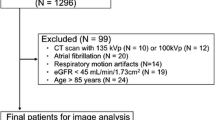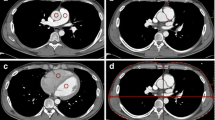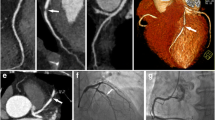Abstract
This retrospective study aimed to evaluate the effects of various patient characteristics, including cardiothoracic ratio (CTR), on vessel enhancement in coronary computed tomography (CT) angiography (CCTA). We screened the 306 patients who underwent CCTA with 80-detector row CT for clinical assessment due to suspected or confirmed coronary artery disease. The change in iodine dose per contrast enhancement (IDCE) (mgI/HU) was calculated as the product of 300 mgI multiplied by total body weight (TBW), divided by the change in Hounsfield unit (HU) obtained by subtracting the HU value. CTR was measured on CT images in scout view. Subsequently, we conducted linear regression analyses among age, sex, body size, CTR, heart rate, scan length, and scan start on IDCE. To evaluate the effects of age, sex, BSA, heart rate, scan length, scan start, and CTR on the IDCE, we used multivariate regression analysis. A significant positive correlation was observed between coronary artery IDCE and patient age (r2 = 0.07, p < 0.01). Linear regression analysis revealed inverse correlations between coronary artery IDCE and height (r2 = − 0.30), total body weight (r2 = − 0.53), body mass index (r2 = − 0.23), body surface area (BSA; r2 = − 0.56), lean body weight (r2 = − 0.50), scan length (r2 = − 0.01), and CTR (r2 = − 0.02). There was no significant correlation between coronary artery IDCE and heart rate (r2 = 0.00, p = 0.74) or scan start (r2 = − 0.01, p = 0.10). Standardized regression coefficients showed that the effect of BSA (− 0.71) was greater than that of other variables (CTR − 0.14, scan start − 0.10). The results of this study showed that patient BSA, CTR, and start scan significantly affect the IDCE of the coronary artery on CCTA images.


Similar content being viewed by others
Data Availability
Clinical data use cannot be disclosed due to ethical concerns.
Code Availability
Not applicable.
Abbreviations
- CCTA:
-
Coronary CT angiography
- CE:
-
Contrast enhancement
- CT:
-
Computed tomography
- CTR:
-
Cardiothoracic ratio
- IDCE:
-
Iodine dose per contrast enhancement
- BSA:
-
Body surface area
- HU:
-
Hounsfield units
- LBW:
-
Lean body weight
- TBW:
-
Total body weight
- BMI:
-
Body mass index
References
Collet C, Onuma Y, Andreini D, Sonck J, Pompilio G, Mushtaq S, et al. Coronary computed tomography angiography for heart team decision-making in multivessel coronary artery disease. Eur Heart J. 2018;39:3689–98.
Ghekiere O, Salgado R, Buls N, Leiner T, Mancini I, Vanhoenacker P, et al. Image quality in coronary CT angiography: challenges and technical solutions. Br J Radiol. 2017;90:20160567.
Sawyer M, Ratain MJ. Body surface area as a determinant of pharmacokinetics and drug dosing. Invest New Drugs. 2001;19:171–7.
Achenbach S. Imaging the vulnerable plaque on coronary CTA. JACC Cardiovasc Imaging. 2020;13:1418–21.
Villines TC, Robinson AA. Will plaque quantification on coronary CTA end our infatuation with lumen stenosis? JACC Cardiovasc Imaging. 2020;13:1718–20.
Nous FMA, Geisler T, Kruk MBP, Alkadhi H, Kitagawa K, Vliegenthart R, et al. Dynamic myocardial perfusion CT for the detection of hemodynamically significant coronary artery disease. JACC Cardiovasc Imaging. 2022;15:75–87.
Cury RC, Leipsic J, Abbara S, Achenbach S, Berman D, Bittencourt M, et al. CAD-RADS™ 2.0 - 2022 Coronary Artery Disease-Reporting and Data System: an expert consensus document of the Society of Cardiovascular Computed Tomography (SCCT), the American College of Cardiology (ACC), the American College of Radiology (ACR), and the North America Society of Cardiovascular Imaging (NASCI). J Cardiovasc Comput Tomogr. 2022;16:536–57.
Schroeder S, Achenbach S, Bengel F, Burgstahler C, Cademartiri F, de Feyter P, et al. Cardiac computed tomography: indications, applications, limitations, and training requirements: report of a Writing Group deployed by the Working Group Nuclear Cardiology and Cardiac CT of the European Society of Cardiology and the European Council of Nuclear Cardiology. Eur Heart J. 2008;29:531–56.
Masuda T, Funama Y, Nakaura T, Satou T, Okimoto T, Yamashita Y, et al. Radiation dose reduction at low tube voltage CCTA based on the CNR index. Acad Radiol. 2018;25:1298–304.
Matsumoto Y, Higaki T, Masuda T, Sato T, Nakamura Y, Tatsugami F, et al. Minimizing individual variations in arterial enhancement on coronary CT angiographs using “contrast enhancement optimizer”: a prospective randomized single-center study. Eur Radiol. 2019;29:2998–3005.
Awai K, Kanematsu M, Kim T, Ichikawa T, Nakamura Y, Nakamoto A, et al. The optimal body size index with which to determine iodine dose for hepatic dynamic CT: a prospective multicenter study. Radiology. 2016;278:773–81.
Masuda T, Nakaura T, Funama Y, Higaki T, Kiguchi M, Imada N, et al. Aortic and hepatic contrast enhancement during hepatic-arterial and portal venous phase computed tomography scanning: multivariate linear regression analysis using age, sex, total body weight, height, and cardiac output. J Comput Assist Tomogr. 2017;41:309–14.
Truszkiewicz K, Poręba R, Gać P. Radiological cardiothoracic ratio in evidence-based medicine. J Clin Med. 2021;10:2016.
Masuda T, Funama Y, Nakaura T, Imada N, Sato T, Okimoto T, et al. CT angiography of suspected peripheral artery disease: comparison of contrast enhancement in the lower extremities of patients undergoing and those not undergoing hemodialysis. AJR Am J Roentgenol. 2017;208:1127–33.
Yanaga Y, Awai K, Nakaura T, Utsunomiya D, Oda S, Hirai T, et al. Contrast material injection protocol with the dose adjusted to the body surface area for MDCT aortography. AJR Am J Roentgenol. 2010;194:903–8.
Boer P. Estimated lean body mass as an index for normalization of body fluid volumes in humans. Am J Physiol. 1984;247:F632–6.
Mosteller RD. Simplified calculation of body-surface area. N Engl J Med. 1987;317:1098.
Du Bois D, Du Bois EF. A formula to estimate the approximate surface area if height and weight be known. Nutrition. 1916;5:303–11.
Yin WH, Yu YT, Zhang Y, An YQ, Hou ZH, Gao Y, et al. Contrast medium injection protocols for coronary CT angiography: should contrast medium volumes be tailored to body weight or body surface area? Clin Radiol. 2020;75:395.e17.
Bae KT, Seeck BA, Hildebolt CF, Tao C, Zhu F, Kanematsu M, et al. Contrast enhancement in cardiovascular MDCT: effect of body weight, height, body surface area, body mass index, and obesity. AJR Am J Roentgenol. 2008;190:777–84.
Goshima S, Kanematsu M, Noda Y, Kondo H, Watanabe H, Kawada H, et al. Determination of optimal intravenous contrast agent iodine dose for the detection of liver metastasis at 80-kVp CT. Eur Radiol. 2014;24:1853–9.
Bae KT. Intravenous contrast medium administration and scan timing at CT: considerations and approaches. Radiology. 2010;256:32–61.
Masuda T, Nakaura T, Funama Y, Sato T, Nagayama Y, Kidoh M, et al. Can machine learning identify the intravenous contrast dose and injection rate needed for optimal enhancement on dynamic liver computed tomography? J Comput Assist Tomogr. 2023;47(4):530–8.
Masuda T, Nakaura T, Funama Y, Okimoto T, Sato T, Higaki T, et al. Machine-learning integration of CT histogram analysis to evaluate the composition of atherosclerotic plaques: validation with IB-IVUS. J Cardiovasc Comput Tomogr. 2019;13:163–9.
Masuda T, Nakaura T, Funama Y, Sugino K, Sato T, Yoshiura T, et al. Machine learning to identify lymph node metastasis from thyroid cancer in patients undergoing contrast-enhanced CT studies. Radiography (Lond). 2021;27:920–6.
Masuda T, Nakaura T, Higaki T, Funama Y, Sato T, Masuda S, et al. Prediction of aortic contrast enhancement on dynamic hepatic computed tomography-performance comparison of machine learning methods and simulation software. J Comput Assist Tomogr. 2022;46:183–9.
Author information
Authors and Affiliations
Contributions
TM: conceived and designed the analysis, collected the data, contributed data or analysis tools, performed the analysis, wrote the paper.
TI: conceived and designed the analysis, collected the data, contributed data or analysis tools, wrote the paper.
HI: conceived and designed the analysis, collected the data.
HS: conceived and designed the analysis, collected the data.
RM: conceived and designed the analysis, collected the data.
DY: conceived and designed the analysis, collected the data.
KY: conceived and designed the analysis, collected the data.
AO: conceived and designed the analysis, collected the data.
JH: conceived and designed the analysis, collected the data.
TT: conceived and designed the analysis, collected the data.
Corresponding author
Ethics declarations
Ethics Approval
This retrospective study was approved by the institutional review board of the Kawasaki Medical School Hospital (No. 5606–00), with the requirement for informed patient consent being waived.
Consent to Participate
Not applicable.
Competing Interests
The authors declare no competing interests.
Additional information
Publisher's Note
Springer Nature remains neutral with regard to jurisdictional claims in published maps and institutional affiliations.
Our submission is not in the public domain as a preprint.
This article is part of the Topical Collection on Imaging.
Rights and permissions
Springer Nature or its licensor (e.g. a society or other partner) holds exclusive rights to this article under a publishing agreement with the author(s) or other rightsholder(s); author self-archiving of the accepted manuscript version of this article is solely governed by the terms of such publishing agreement and applicable law.
About this article
Cite this article
Ishikawa, T., Masuda, T., Ikenaga, H. et al. Effect of Patient Characteristics, Including Cardiothoracic Ratio, on Vessel Enhancement in Coronary Computed Tomography Angiography. SN Compr. Clin. Med. 6, 9 (2024). https://doi.org/10.1007/s42399-024-01639-9
Accepted:
Published:
DOI: https://doi.org/10.1007/s42399-024-01639-9




